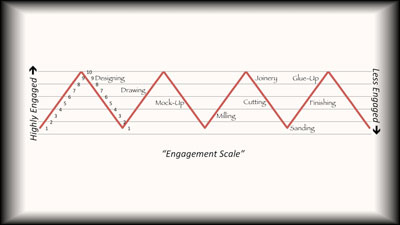
 by Steven D. Johnson
by Steven D. Johnson
Racine, Wisconsin
(Page 3 of 4)
Previous Page
1
2
3
4
Next Page
Just Killin' Time
Click on any picture to see a larger version.
Saw a quote the other day (obviously from a kindred spirit) to the effect, "I drink coffee to kill time until it's time to drink wine."
Personally, I "kill time sleeping until it's time to be awake again." Sleeping is such a waste of time… oh, to be like Thomas Edison! Truth is, I "kill time doing anything other than woodworking until it's time to do woodworking." My buddies "kill time sanding until it's time to apply a finish." It is fascinating to think about all the things we might consider "killing time."
What we are really talking about here is boredom… or what psychologists call the "unengaged mind." John Eastwood, PhD, York University, says boredom is the "unfulfilled desire for satisfying activity."
What engages the mind and what disengages it varies significantly among woodworkers. There are also degrees of engagement, or the lack of boredom, ranging from "totally engaged" to "somewhat engaged" to "mildly engaged," then trending towards boredom we have "mildly disengaged" and "totally disengaged." And, of course, there are alternative activities that our minds undertake, in varying degrees, at each level of engagement.

|
Figure 13 - We all flow naturally from states of high
engagement to states of low engagement,
but the reasons vary
|
The peaks and valleys of engagement and boredom may align broadly with different steps or processes, or there may be peaks and valleys within specific steps and processes. For example, when making the locking joint for the drawers on the SawStop Outfeed Table project I flowed from a state of high engagement to a state of virtual detachment and back several times within the course of this one step.
Figuring out the dimensions of pieces needed to make the drawer boxes was challenging, particularly with undersize plywood and tight side-to-side tolerances. After noodling that out, however, cutting the pieces to size was a mindless task. Setting up the first cut to make the rabbets in the front and back pieces took some seriously engaged thought and several trials… but once everything was set, the sixteen individual cuts were "ho-hum." Setting up to make the matching receiving dado on the side pieces was again exciting, requiring several test cuts and precise set-up. And, again, once everything was set, the actual cuts were relatively jejune exercises.
All of this analysis of relative engagement while woodworking has important ramifications. No one can argue that while totally engaged in any woodworking activity we are (a) less likely to make a mistake, (b) less likely to do something dangerous, and (c) having more fun. High engagement is what we oftentimes refer to as "being in the zone." Our goal should be to identify the activities in which we are "less engaged" and somehow make them more engaging.
There are several strategies for turning the mundane to interesting, turning ennui to excitement, to turn the "old hat" into a "new trick." The easiest is simply to "shake it up." Change a routine by trying something new…
Do you pride yourself on hand-cutting perfect dovetails? Get a good jig and try cutting them with a router. Or vice versa. You like cutting dados on the table saw? Try it with a router and bit. Or vice versa. I'm shaping curved pieces for the back of a bench right now. Normally I cut curves on the band saw and shape on the drum sander. This time I'm using shaves for shaping. Do you use pocket screws? Try dowels, biscuits, or loose tenons. Or vice versa. Shake it up! Change it up! Get a new tool and learn to use it, even if you have another method that has always worked for you. Simply doing something a new and different way will heighten the mental engagement level.
There will always, of course, be steps along the continuum that are less engaging than others, and assuming that these are processes that have inherently little danger (like sanding) it is possible to become more engaged, and have more fun, by not just letting the mind wander aimlessly, but by giving it direction. Pick a specific challenging, engaging, or exciting woodworking subject and focus the thought processes. Frankly, I usually design a new project in my mind while sanding and finishing the current project.
Do you have a friend that is new to woodworking? Have you noticed that he or she is excited about everything… and I mean everything? New woodworkers are totally "into" things many of us would consider rote. Everything is fascinating and challenging, and they are totally engaged with every single step in the process. If this newbie exuberance were available in pill form, I would buy a bottle.
Time is one of the most precious commodities woodworkers have, and it must be used wisely. Next month we will explore a little deeper this concept of "killing time" and what we can do to make every shop minute more productive, safer, and more fun.
(Page 3 of 4)
Previous Page
1
2
3
4
Next Page
Return to
Wood News
front page

